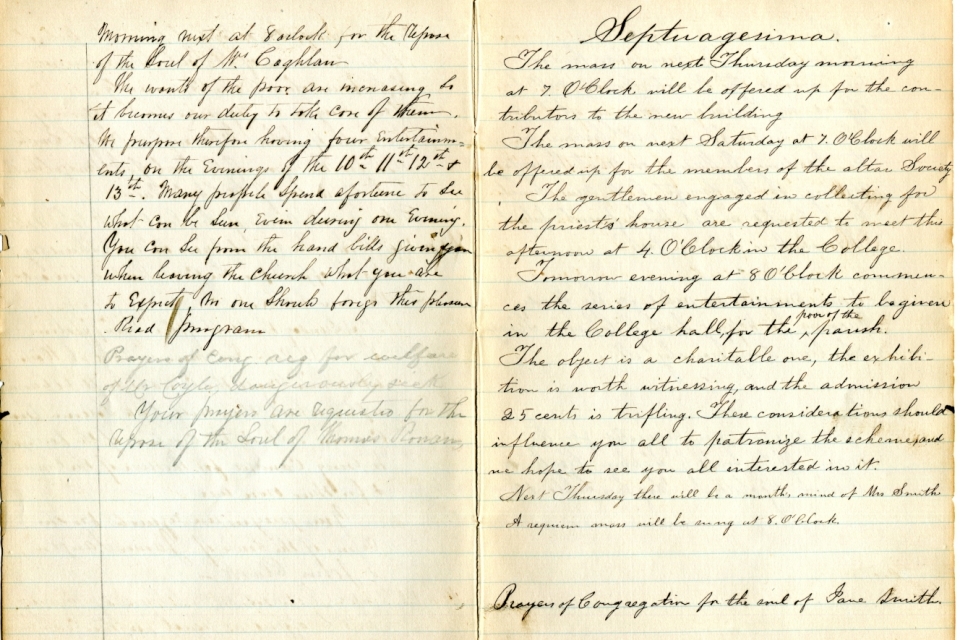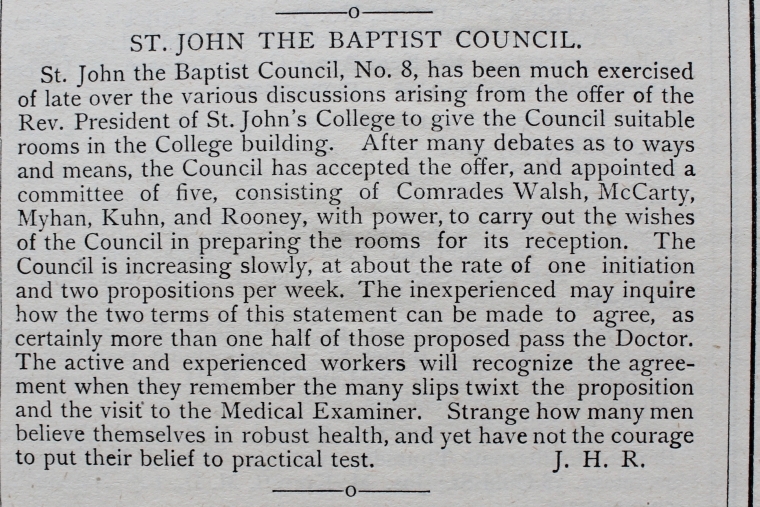- Home
- Digital History Exhibit
- Charity and Service
Digital History Exhibit
- Bishop Loughlin's Vision and the Vincentian Mission
- Catholic Education
- Places of Worship
- Charity and Service
- Brooklyn Campus History
- Queens Campus History
- Staten Island Campus History
- Manhattan Campus History
- Long Island and International Location History
- Student Organizations
- The Campus Experience
- Student Publications
- The Early Colleges
- The Newest Colleges
- The Professional Colleges
- The Libraries and Archives
Charity and Service
St. Vincent de Paul’s legacy of acts of charity and personal service to the poor are reflected in the many charitable programs, student organizations, and other initiatives led by St. John’s University.
Fundraising for the Poor
Even in the earliest years of its history, the St. John’s community considered it their duty to care for the poor. These entries in the 1873 Sunday Announcement book of the Church of St. John the Baptist announce a series of “entertainments” to raise money for the poor people of the parish. Numerous fundraising events such as these were held every year by the college and the parish.

Left page: “The wants of the poor are increasing so it becomes our duty to take care of them. We propose therefore having four entertainments on the evenings of the 10th 11th 12th + 13th. Many people spend a fortune to see what can be seen, even during one evening. You can see from the hand bills given you when leaving the Church what you are to expect, no one should forget this pleasure.”
Right page: “Tomorrow evening at 8 o’clock commences the series of entertainments to be given in the College hall, for the poor of the parish. The object is a charitable one, the exhibition is worth witnessing, and the admission 25 cents is trifling. These considerations should influence you all to patronize the scheme, and we hope to see you all interested in it.”
The Catholic Benevolent Legion
According to the November 1882 issue of The Record of the Catholic Benevolent Legion (CBL), the object of the society was to be a social, fraternal, and insurance organization, providing for the families of sick and disabled or deceased members. St. John the Baptist Council No. 8 was founded on February 16, 1882 with 13 charter members. In March 1883, the Rev. President of St. John’s College offered rooms in the college building on Lewis Avenue in Brooklyn where the CBL could meet.
The September 1883 issue of The Record reported on the first seven deaths of members of the CBL. Death number six was of a member of the St. John the Baptist Council No. 8: Peter Gill, a painter. He was admitted to the CBL on February 16, 1882 (a charter member) at age 58, and died on April 19, 1883. He had paid $20.70 in assessments so far, and his beneficiaries would receive $2,813.63.
On April 13, 1885, the first social event hosted by the St. John the Baptist Council No. 8 was held at St. John’s College Hall on Lewis Avenue, and included musical and literary entertainment (an hour-long oratory performance on labor and the workingman in America and Europe) with closing remarks by Rev. J. A. Hartnett, C.M., president of St. John’s College.

Blood Drives
St. John’s University first began to organize blood drives during World War II. A War Bond Rally was held in the school library in December of 1944 to commemorate the 3rd anniversary of Pearl Harbor. The students were asked to purchase war bonds and donate blood for the troops. In addition to continuing to support the troops during other conflicts, such as the Korea War in the 1950s, the contributions also went towards the St. John’s Blood Bank, which was made available to St. John’s students and their families in times of need. A page from the 1951 Vincentian yearbook shows former President of St. John’s, Fr. Flynn, participating in the blood drive along with the students. Through the decades, St. John’s has continued to organized annual blood drives in times of conflict and times of peace to help save lives. In 2017, St. John’s earned the “College with the Most Donations” Award for donating 798 pints of blood during the Diocese of Brooklyn’s 2016 Blood Drive Campaign.

Student Organizations
Since the University’s founding in 1870, St. John’s students have demonstrated their Vincentian spirit through academic as well as extra-curricular pursuits. In addition to theology coursework and attendance at Mass at St. John the Baptist Church in Brooklyn or at St. Thomas More Church in Queens, many religious and charitable student organizations were formed over the years. The earliest known religious student group was founded in 1902 as the Sodality of the Immaculate Conception (also called the Sodality of the Blessed Virgin Mary). The members attended meetings, lectures, mass, and retreats to enhance their spiritual and moral training, and demonstrate their devotion to the Blessed Mother Mary.
Through the end of the 1930s, several other religious and service-oriented student groups emerged. The Crusaders (also called the Crusade Society) began in the early 1920s. They raised funds to aid the Vincentian missionaries in China, as well as to support the needy of the local parish, through bridge and dance parties and weekly collections.
The Speakers Association was founded in 1929-1930 for the purpose of training students as orators and for the establishment of a Speakers Bureau, which would provide students ready to speak on various topics of Catholic interest, free of charge to various organizations and societies around the city and beyond. Just a few years after its inception, the Speakers Association was estimated to have given approximately 800 lectures. The group eventually included undergraduate and graduate-level students as well as alumni, and even broadcast some of their lectures over the radio. (Vincentian 1936)
The Minute Men, founded in 1933, “concerned themselves with the rousing of the public interest through the writing of letters to newspapers and magazines on all topics of current Catholic interest,” (Vincentian 1935) as well as sending petitions and letters to politicians.
The Roger Bacon Scientific Society was founded in 1922-1923 for the purpose of “encouraging and promoting scientific studies and aiming to show that Religion and Science are not incompatible.” (Vincentian 1929) The Society still exists as a student organization today.
The main religious club for the students of pharmacy at St. John’s University was St. Luke’s Society, named after the patron saint of pharmacy, founded in 1932. (Pharmalog 1932)
The mission of the St. Thomas Aquinas Society, founded in 1928, was “the promotion of the spiritual, social, and professional well-being of the Society’s members in conformity with Catholic ideals of right living.” (Res Gestae, 1941) After World War II, the group was reorganized as the St. Thomas More Society, solely for the Catholic students of the School of Law. The new mission was to “instill in its membership a constant awareness that the practice of law furnishes an excellent opportunity to practice the principles of applied Catholicism.” (Res Gestae, 1948-1949) The group transformed once again, reinstated as the St. Thomas More Institute for Legal Research in July 1954. While no longer a student-run organization, the most qualified law students participated in the Institute’s activities, including assisting in the research and editing of articles for The Catholic Lawyer, first published by the St. John’s University School of Law in January 1955. This journal is still published today as The Journal of Catholic Legal Studies, and is available to read online in the Law School’s repository.
From the 1940s to the 1960s, many passionate students served the spiritual needs of the campus community and local parishes through student organizations. Some of the new student clubs during this era included the Father Dodd Altar Society (male students who served at masses and other religious services at the chapel at St. John’s), the Marillac Tabernacle Society (female students who prepared the chapel for services), the Legion of Mary, the Children of Mary, the Confraternity of Catholic Doctrine, Delta Sigma Chi (social service and care of orphans), and the Catholic Action Club (students in University College at the Brooklyn campus). There was also a new Eastern Rites Society to serve the needs of students from the Eastern Catholic Churches. Many of the earliest clubs continued to exist as well, often with great popularity among the University’s Catholic members.
The next few decades, beginning in the mid-1960s, brought in a slightly different focus: community service and social justice. Some of the new clubs of this era included RELAY (Religious Education for Latin American Youth), CAUSE (Community and University Services in Education), and Circle K. From the 1980s on saw the emergence of even more student organizations, such as the St. Vincent de Paul Society, the Christian Fellowship, the Chinese Christian Fellowship, Voices of Victory (gospel music), as well as ongoing student participation in Campus Ministry.
Today’s students are still very active in religious, community service, and social justice student organizations on and off campus, reflecting the Vincentian traditions of charity and service.

